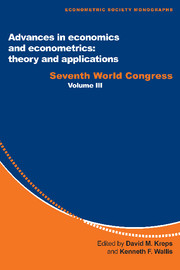Book contents
- Frontmatter
- 1 Causal analysis and statistical inference on possibly non-stationary time series
- 2 Cointegration, long-run comovements, and long-horizon forecasting
- 3 Testing and measurement in competition models
- 4 Empirical equilibrium search models
- 5 Posterior simulators in econometrics
- 6 Restricted least squares subject to monotonicity and concavity constraints
- 7 Bootstrap methods in econometrics: theory and numerical performance
- 8 Econometric models of option pricing errors
- 9 New minimum chi-square methods in empirical
- Index
2 - Cointegration, long-run comovements, and long-horizon forecasting
Published online by Cambridge University Press: 05 January 2013
- Frontmatter
- 1 Causal analysis and statistical inference on possibly non-stationary time series
- 2 Cointegration, long-run comovements, and long-horizon forecasting
- 3 Testing and measurement in competition models
- 4 Empirical equilibrium search models
- 5 Posterior simulators in econometrics
- 6 Restricted least squares subject to monotonicity and concavity constraints
- 7 Bootstrap methods in econometrics: theory and numerical performance
- 8 Econometric models of option pricing errors
- 9 New minimum chi-square methods in empirical
- Index
Summary
INTRODUCTION
Over the past decade, methodological advances in modeling and analyzing long-run relations have produced fundamental changes in the way that econometricians approach economic time-series data. Prior to these advances, econometric analysis of time-series data either ignored the problems which arise when regressors are highly persistent, or used a preliminary transformation to induce stationarity followed by analysis of the transformed variables. Now, the concept of cointegration, developed by Granger (1981), Granger and Weiss (1983), and Engle and Granger (1987), which builds on work on error correction models (Sargan (1964) and Davidson, Hendry, Srba, and Yeo (1978)), provides a powerful and widely adopted framework for studying long-run as well as short-run relations.
This chapter undertakes a selective survey of some recent theoretical work and focuses on some problems which remain in this area. The thesis of this chapter is that, although the modern methodology of cointegration/unit root analysis provides a compelling framework for some problems, such as short-term forecasting using long-run information, for some applications this methodology has important limitations. The limitations of concern here arise when some of the regressors have an autoregressive root which is large but, in contrast to the basic assumption of cointegration analysis, not exactly one.
- Type
- Chapter
- Information
- Advances in Economics and Econometrics: Theory and ApplicationsSeventh World Congress, pp. 34 - 60Publisher: Cambridge University PressPrint publication year: 1997
- 11
- Cited by



